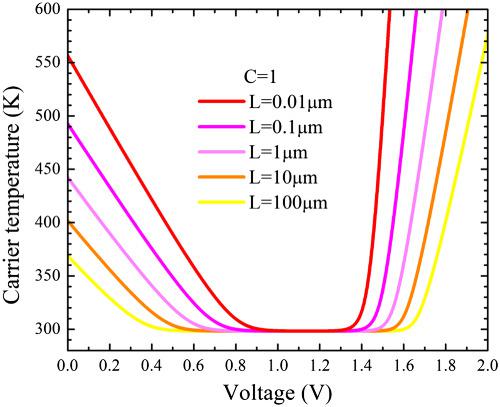当前位置:
X-MOL 学术
›
Prog. Photovoltaics
›
论文详情
Our official English website, www.x-mol.net, welcomes your
feedback! (Note: you will need to create a separate account there.)
Theoretical model and simulation of carrier heating with effects of nonequilibrium hot phonons in semiconductor photovoltaic devices
Progress in Photovoltaics ( IF 8.0 ) Pub Date : 2018-05-17 , DOI: 10.1002/pip.3021 Chin‐Yi Tsai
Progress in Photovoltaics ( IF 8.0 ) Pub Date : 2018-05-17 , DOI: 10.1002/pip.3021 Chin‐Yi Tsai

|
A theoretical model and its rate equations of carrier number and energy densities are proposed and presented for calculating carrier heating in semiconductor photovoltaic devices. The rate equation for carrier number density is the Shockley‐Queisser theoretical model, while the rate equation for carrier energy density includes the carrier interband energy relaxation via radiative recombination and the intraband energy relaxation via the interactions between carriers and polar longitudinal optical phonons. The carrier intraband energy relaxation is calculated by incorporating the effects of nonequilibrium hot phonons and the Thomas‐Fermi static screening. This model and its rate equations are employed for numerical simulations of the magnitude of carrier heating and its effects on the current‐voltage relations of bulk GaAs solar cells under different concentration ratios and with different widths of the active region. The simulation results demonstrate that carrier temperature in general heats up to 400 to 900 K at short‐circuit operating condition. This carrier heating cools down to lattice temperature when the device approaches its open‐circuit point. Based on these numerical results, effects of carrier heating on the performance of conventional solar cells and also their implications for the design of hot‐carrier solar cells will be discussed.
中文翻译:

半导体光伏器件中非平衡热声子对载流子加热的理论模型与仿真
提出了载流子数和能量密度的理论模型及其速率方程,提出了计算半导体光伏器件载流子热量的方法。载流子数密度的速率方程是Shockley-Queisser理论模型,而载流子能量密度的速率方程包括通过辐射复合产生的载带间能量弛豫和通过载流子与极性纵向光子之间的相互作用产生的带内能量弛豫。载波带内能量弛豫是通过结合非平衡热声子和Thomas-Fermi静态屏蔽的影响来计算的。该模型及其速率方程被用于数值模拟载流子加热的幅度及其对不同浓度比和不同有源区宽度的GaAs太阳能电池电流-电压关系的影响。仿真结果表明,在短路操作条件下,载流子温度通常会高达400至900K。当设备接近其开路点时,这种载流子的热量会冷却至晶格温度。基于这些数值结果,将讨论载流子加热对常规太阳能电池性能的影响,以及它们对热载流子太阳能电池设计的影响。仿真结果表明,在短路操作条件下,载流子温度通常会高达400至900K。当设备接近其开路点时,这种载流子的热量会冷却至晶格温度。基于这些数值结果,将讨论载流子加热对常规太阳能电池性能的影响,以及它们对热载流子太阳能电池设计的影响。仿真结果表明,在短路操作条件下,载流子温度通常会高达400至900K。当设备接近其开路点时,这种载流子的热量会冷却至晶格温度。基于这些数值结果,将讨论载流子加热对常规太阳能电池性能的影响,以及它们对热载流子太阳能电池设计的影响。
更新日期:2018-05-17
中文翻译:

半导体光伏器件中非平衡热声子对载流子加热的理论模型与仿真
提出了载流子数和能量密度的理论模型及其速率方程,提出了计算半导体光伏器件载流子热量的方法。载流子数密度的速率方程是Shockley-Queisser理论模型,而载流子能量密度的速率方程包括通过辐射复合产生的载带间能量弛豫和通过载流子与极性纵向光子之间的相互作用产生的带内能量弛豫。载波带内能量弛豫是通过结合非平衡热声子和Thomas-Fermi静态屏蔽的影响来计算的。该模型及其速率方程被用于数值模拟载流子加热的幅度及其对不同浓度比和不同有源区宽度的GaAs太阳能电池电流-电压关系的影响。仿真结果表明,在短路操作条件下,载流子温度通常会高达400至900K。当设备接近其开路点时,这种载流子的热量会冷却至晶格温度。基于这些数值结果,将讨论载流子加热对常规太阳能电池性能的影响,以及它们对热载流子太阳能电池设计的影响。仿真结果表明,在短路操作条件下,载流子温度通常会高达400至900K。当设备接近其开路点时,这种载流子的热量会冷却至晶格温度。基于这些数值结果,将讨论载流子加热对常规太阳能电池性能的影响,以及它们对热载流子太阳能电池设计的影响。仿真结果表明,在短路操作条件下,载流子温度通常会高达400至900K。当设备接近其开路点时,这种载流子的热量会冷却至晶格温度。基于这些数值结果,将讨论载流子加热对常规太阳能电池性能的影响,以及它们对热载流子太阳能电池设计的影响。











































 京公网安备 11010802027423号
京公网安备 11010802027423号